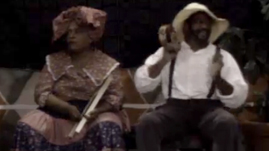Teachers' Domain - Digital Media for the Classroom and Professional Development
User: Preview



The Plantation Dance/Ring Shout represents a style of dance and music found in African slave communities on plantations in the southern United States, Caribbean Islands, and other locations. Slaves worked from sun up to sun down and did not have much time for "social gatherings." However, they would often gather at night and entertain one another with music and dance. The plantation dance, or juba (giouba) dance, seen in this video clip was often danced in a group around two performers. In the clip, Imani Dance and Drum Company, based in Louisville, Ky., performs an example of such a dance.
Find additional arts resources for your classroom at the KET Arts Toolkit website.
Enslaved Africans were torn from their homelands and forced onto plantations throughout the southern United States, Caribbean Islands, and other locations. The harsh institution of slavery attempted to strip its victims of their native culture. Slaves were forced into the culture of their owners and expected to live a life of servitude to their masters. Many danced as a way to cope with their situation and to convey feelings about their lives and owners. Despite this, these plantation dances were often joyful celebrations, with dancers using their voices, hands, and feet and slapping their hands against their knees. As in Africa, the dance was for everyone, but each person entered the dance based on age and gender. Through music and dance, Africans were able to hold on to some of their cultural heritage.
Slave music on plantations in the United States typically consisted of field hollers, call-and-response patterns, shouts, slurs, cries, and moans and made use of homemade instruments from the banjo, tambourine, and calabashes to washboards, pots, and spoons. Beginning in the 1740s, many states banned the use of drums in slave communities because it was feared that slaves would use them to create a system of communication to support rebellion. However, slaves continued to make rhythmic music using homemade instruments and their bodies for percussive sounds.
 Loading Standards
Loading Standards